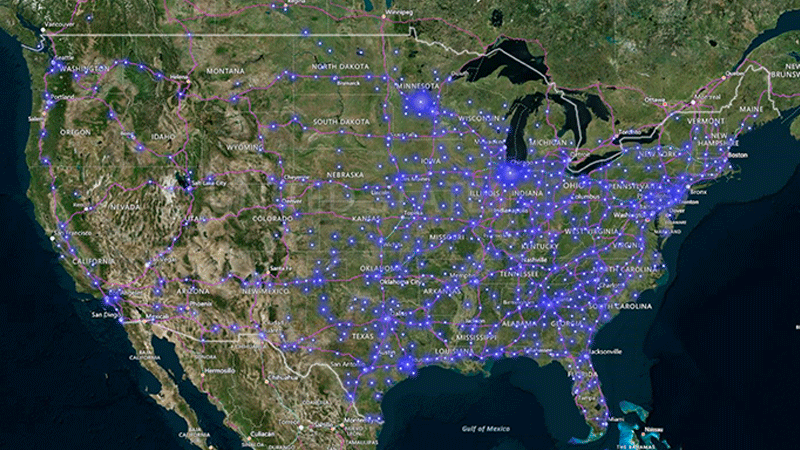
The best freight carriers track loads to confirm progress, spot risks early, and keep shippers in the loop. But if you're working with a broker — which doesn't own trucks or employ drivers — for the first time, you may be worried about the visibility of your shipments.
Good news: there's no cause for concern. You can still track your freight with a high level of transparency and timeliness when working with a freight brokerage. In fact, it's your broker's job to provide you with all the details you need in the manner that best suits your communication preferences.
ATS Logistics has been helping freight get from Point A to Point B for over three decades. From the days of phone calls and pen-and-paper tracking to today's self-service, all-digital tools, you could say we've been tracking the progress of freight tracking for as long as we've been in business!
In this blog, we’ll break down the methods brokers use to track freight, the benefits of each of those methods for shippers, and how vetting brokerages on shipment visibility can help you prevent surprises and protect on-time performance.
Key Takeaways for Shippers:
- Freight tracking is ETA protection. It verifies load location, whether it’s moving on schedule, and what (if anything) could threaten delivery timelines.
- Brokerages track freight in multiple ways, depending on the carrier's technology and shipper's preferences.
- Better visibility improves dock planning, labor scheduling, and limit avoidable accessorials.
- Early delay signals speed up exception management and communication.
- Vet brokers on tracking standards: update cadence, ETA accuracy, exceptions, EDI/portal access.
What is Freight Tracking in Commercial Shipping?
In simple terms, tracking freight is the process of verifying where a load is, whether it’s moving as planned, and what might threaten its ETA.
Sometimes that means tapping into carrier-provided GPS updates. Other times, it can mean:
- Check-in calls
- App-based location pings
- Digital visibility platforms
- Geofencing around pickup and delivery points
. . . and good, old-fashioned person-to-person communication when the situation gets complex.
The goal is the same either way: to keep shippers informed, receivers prepared, and keep service consistent— even when there's unexpected roadblocks on the path.
How Freight Brokers Use Load Tracking Systems (And Why It Matters)
The best freight brokers use multiple methods of load tracking to protect on-time performance and keep shippers informed from pickup to delivery.
The best outcomes happen when a carrier can share in-transit visibility through a load tracking system, but brokers typically use a few different methods depending on the carrier’s technology and preferences.
At a high level, freight brokers track freight using:
- Electronic logging devices (ELDs)
- Mobile load tracking apps
- Scheduled check calls (phone updates)
Ideally, your broker will offer at least two options through which you can get visibility into where your shipment is and what's happening next.
Each method offers a different degree of visibility, shipper self-service, and customer service, but all help brokers monitor shipment progress, confirm ETAs, and respond quickly when a load starts drifting off plan.
![]()
Tracking Freight Via Electronic Logging Devices (ELDs)
ELDs are widely used across trucking to record hours of service (HOS) and support compliance. Because ELDs are already installed in many trucks, they can also be used as a reliable source of location updates when the carrier’s system integrates with a broker’s visibility tools or a third-party freight tracking platform.
For brokers, ELD load tracking can provide:
- In-transit location visibility
- More consistent shipment updates
- Earlier awareness of delays that could impact the delivery appointment
How ELDs helps shippers: With better visibility into shipment status and ETA, shippers can plan labor and dock schedules more accurately, reduce last-minute fire drills, and limit avoidable accessorial costs tied to poor coordination.
![]()
Tracking Freight Via Mobile Applications
Many brokers also rely on mobile freight tracking apps that capture location pings while a driver is in transit. These tools are popular because they’re easy for drivers to use and can provide timely updates without requiring deep hardware integrations.
Mobile app tracking often supports updates like:
- Pickup confirmation and departure time
- In-transit location check-ins
- ETA updates based on real-time movement
How this helps shippers: App-based tracking improves shipment visibility and gives brokers faster signals when something is changing, so they can communicate early and coordinate options before a minor delay becomes a major disruption.
![]()
Tracking Freight Via Check Calls
Not every carrier uses ELD integrations or mobile tracking, and sometimes visibility tools fail at the worst possible moment. When that happens, brokers fall back on the most dependable technology of all: a phone call.
With check calls, brokers set a proactive communication cadence to collect:
- Current location
- Progress against schedule
- Updated ETA and appointment risk
The broker then communicates these updates to the shipper on a cadence that matches their need and preferences.
How this helps shippers: Even without automated visibility, consistent updates allow shippers to adjust receiving plans, manage exceptions, and avoid getting blindsided by late deliveries.
How to Vet Freight Brokers on Tracking Capabilities
From a shipper’s seat, load tracking isn’t about watching a truck crawl across a map like a video game character. It’s about getting reliable answers to the questions that affect your day and supply chain, like:
- Will it arrive when you planned?
- Do you need to adjust labor or dock schedules?
- Is the delivery appointment still realistic?
- If something’s going sideways, how soon will you know?
That's why it's important for shippers to look for freight brokers that treat tracking as a core service and valuable investment, not an afterthought.
As you vet brokers to add to your transportation network, ask what their “standard” shipment visibility looks like:
- How often you’ll receive status updates
- Whether they can provide near real-time location and ETA changes
- How they handle exceptions
- Whether you can access updates through EDI or a customer portal
-
Better planning at the dock: More accurate ETAs help you stage product, schedule labor, and prep equipment so loading and unloading runs smoother.
-
Fewer disruptions and surprise costs: Proactive updates can reduce avoidable detention, layovers, and other accessorial charges that can pop up when timing and communication break down.
-
Faster exception management: If weather, traffic, or a missed appointment threatens delivery, tracking gives a broker the signal to escalate early, propose options, and keep your team aligned.
-
More predictable customer service: When your customers ask “Where’s my freight?”, you don't have to guess. You'll have a confident answer, a realistic ETA, and (if needed) a recovery plan.
-
Less internal chaos: Fewer emergencies, fewer frantic emails, and fewer status meetings that exist only because nobody trusts the timeline.
In other words, good freight tracking is a service multiplier. Whether visibility comes from ELD integrations, mobile load tracking apps, or plain check calls, the value of choosing a brokerage that can provide it is the same: more predictability, fewer headaches, and better control over outcomes from pickup to delivery.
The Best Freight Brokers Can Answer "Where's My Truck?" — and Then Some
At the end of the day, freight brokers can absolutely provide freight tracking that satisfies your needs — but the real value-add is the additional communication, problem-solving, and data that comes with their capabilities.
Brokers with robust load tracking capabilities and consistent communication practices can give shippers more accurate ETAs, earlier warnings when a load is at risk, and fewer last-minute scrambles at the dock.
They can also act in your best interest to plan contingencies, relay critical information back and forth between shippers, carriers, and stakeholders, and protect shippers from the hassle of monitoring load progress and managing potential hiccups.
That means smoother scheduling, fewer avoidable accessorial costs, and more confidence when your team or your customers need a reliable update. In short: good freight tracking capabilities — and good freight brokers — don’t just find the truck, they protect the plan.
If you're looking for a freight brokerage that can arm you with knowledge via ELD data, a digital self-service portal, and proactive communication, consider giving ATS Logistics a call. We prioritize shipment visibility to ensure you and your shipments are never left in the dark or by the wayside.




